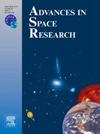Phase space deep neural network with Saliency-based attention for hyperspectral target detection
IF 2.8
3区 地球科学
Q2 ASTRONOMY & ASTROPHYSICS
引用次数: 0
Abstract
The accurate separation of targets and background is challenging in hyperspectral target detection algorithms, due to the high variability and complex non-linear scattering interactions in spectra acquired by imaging spectrometers. Moreover, the target regions may be contaminated by the background signal in real images, hindering the separation of a specific target in a scene. To address these challenges, a deep neural network is proposed in this work, consisting of three modules. First, to extract features hidden in the spectral signature of pixels, the hyperspectral image is considered as a dynamic system, and its phase space is reconstructed in the spectral feature space. Subsequently, in order to highlight the targets and suppress the background, a saliency map is produced, which shows candidate regions for the targets of interest. The saliency map is then utilized as an attention map for weighting the hyperspectral input within the network. The proposed multi-branch deep neural network processes each dimension of the reconstructed phase space. The resulting Phase Space Deep Neural Network with Saliency-based Attention (PSDNN-SA) outperforms several state-of-the-art detectors both quantitatively and visually in experiments carried out on different real hyperspectral subsets.
基于显著性关注的相空间深度神经网络用于高光谱目标检测
由于成像光谱仪获取的光谱具有高变异性和复杂的非线性散射相互作用,高光谱目标检测算法中目标与背景的准确分离是一个挑战。此外,真实图像中的目标区域可能受到背景信号的污染,阻碍了场景中特定目标的分离。为了解决这些挑战,本文提出了一个由三个模块组成的深度神经网络。首先,为了提取隐藏在像元光谱特征中的特征,将高光谱图像视为一个动态系统,在光谱特征空间中重构其相空间;随后,为了突出目标和抑制背景,生成显著性图,其中显示感兴趣目标的候选区域。然后利用显著性图作为注意图,对网络中的高光谱输入进行加权。提出的多分支深度神经网络对重构相空间的每个维度进行处理。在不同的真实高光谱子集上进行的实验中,所得到的基于显著性注意的相空间深度神经网络(psdn - sa)在数量和视觉上都优于几种最先进的检测器。
本文章由计算机程序翻译,如有差异,请以英文原文为准。
求助全文
约1分钟内获得全文
求助全文
来源期刊

Advances in Space Research
地学天文-地球科学综合
CiteScore
5.20
自引率
11.50%
发文量
800
审稿时长
5.8 months
期刊介绍:
The COSPAR publication Advances in Space Research (ASR) is an open journal covering all areas of space research including: space studies of the Earth''s surface, meteorology, climate, the Earth-Moon system, planets and small bodies of the solar system, upper atmospheres, ionospheres and magnetospheres of the Earth and planets including reference atmospheres, space plasmas in the solar system, astrophysics from space, materials sciences in space, fundamental physics in space, space debris, space weather, Earth observations of space phenomena, etc.
NB: Please note that manuscripts related to life sciences as related to space are no more accepted for submission to Advances in Space Research. Such manuscripts should now be submitted to the new COSPAR Journal Life Sciences in Space Research (LSSR).
All submissions are reviewed by two scientists in the field. COSPAR is an interdisciplinary scientific organization concerned with the progress of space research on an international scale. Operating under the rules of ICSU, COSPAR ignores political considerations and considers all questions solely from the scientific viewpoint.
 求助内容:
求助内容: 应助结果提醒方式:
应助结果提醒方式:


